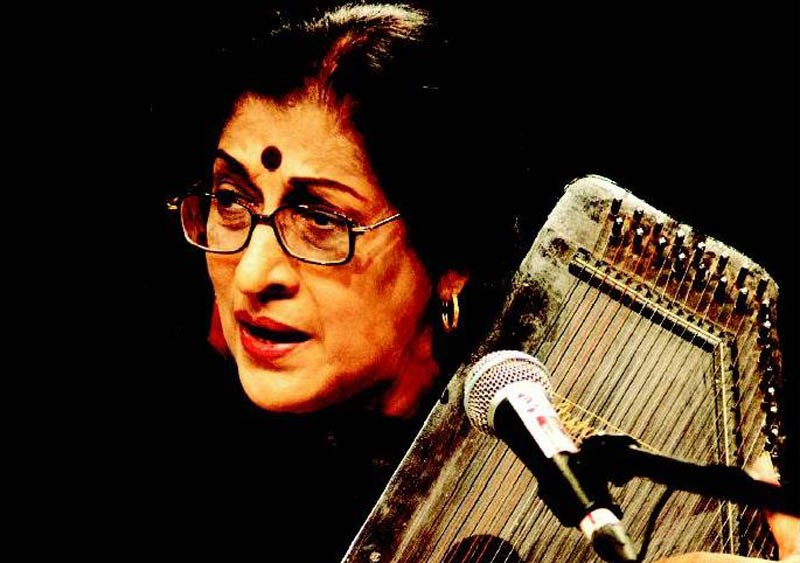
A look at Kishori Amonkar’s contribution to classical music in India

Kishori Amonkar who died recently was undoubtedly the most outstanding vocalists of kheyal and thumri. She represented the changing times and did not stick to one style or tradition of classical music, but was willing to accept other influences and meld them into her own sensibility of what a vocalist was supposed to mean in the second half of the twentieth century. While listening to her, it was apparent that her music was eclectic -- made up of many streams rather than only one.
This assimilation and melding was a much deliberated affair -- to form her own original style. All these changes were overlaid on her own inherited musical style because the moment she sang, it became clear that her roots were firmly set in the Atruli Jaipur Gharana.
In a rapidly changing world, the information and influences are so overwhelming that they tend to sweep the person off his or her feet. In the end, the art product is only a combination of many influences, not properly assimilated to form an organic whole form. This is the characteristic of much that is happening in today’s world. It is basically this eclecticism, as an expression of resignation or inevitability, becoming a virtue in itself in contemporary era whether in ideology, politics, academia or art.
But Kishori Amonkar absorbed aplenty without losing her bearings.
She was a stickler for perfection, and found many a time the environment not conducive for seriousness that her performances demanded. She was often upset, and was labelled as a very temperamental person.
From the patronage of the princely states, which was a standard norm to a new set of patrons, usually in the form of the urban rich, the rules of decorum involving patronage also underwent a change in style. In India the state moved in, and with it the bureaucracy to replace the pattern of patronage.
That caused problems for the artistes nurtured in the traditional mould who preferred the patron to be initiated into the arts rather than just be performing a petty assignment, in line with the duty as executer of state policy. The urban rich and the state apparatus often had other priorities, traditionally associated with show business, and that often irritated the old school of artistes and patrons.
But artistes are supposed to be temperamental -- and her presence usually meant that the patrons or the listeners could not take her lightly. Though her formative years were spent in the period when the classical forms were patronised by the princely states with show business located mostly in Bombay and Calcutta, her talent really blossomed after independence.
In the beginning, she had formidable elders to compete with like Kaiser Bai Kakkar, Gangubai Hangal Rasoolan Bai and Girija Devi (Roshan Ara having migrated to Pakistan). But after they passed or were incapacitated by age she became the undisputed queen of kheyal and thumri from the 1960s onwards. She was thus the leading vocalist among women, a bridge between the next generations born in independent India like Parveen Sultana. Till almost the very end she retained the strength of her voice and command over the craft -- perhaps only dimmed in the last few years due to age. She was singing, and being looked up to by at least two succeeding generations.
She was educated in music by her mother Mogubai Kurdikar who was the shagird of none other than Ustad Alladiya Khan. Mogubai Kurdikar was a competent vocalist but Kaisar Bai, her guru Behan (had the same teacher), was truly outstanding and dominated the music scene in the 1940s and 50s.
Alladiya Khan was born in the middle of the nineteenth century and, as a very well known singer was sought by the various courts. He was born to a family of dhrupad singers; as he moved from Jaipur court to Shahu Maharaj court there was a dissociation from a certain type of musical community and an attempt to face up to the new demands made on the singer. The incorporation of the North Indian classical music into the cultural life of Maharashrata had far-reaching implications for the fundamental character of music.
Side by side with the forms of courtly patronage were the opportunities offered by the cities of Calcutta and Bombay, centres of consumption of cultural products but yet to become a permanent home to gharanedaar artistes. The world of music that retained the mystery and fable like quality lasted till the end of the nineteenth century. This was the time when khayal gaiki was being accepted as the major form of classical music and some of the legendary names associated with this genre dominated the field.
It was the sign of changing times that Kishori Amonkar started to sing bhajans but not in the form of the song format which the popular religious resurgence in the late 19th century and then the films made widespread but in line with the exploration of the raag. Meera Bai had set a standard for everyone, especially the women artistes. Time and again, her compositions were rendered in varying the style by a whole lot of successive vocalists and composers. It was like the kaafi which was rendered in the raag mode by various Punjabi vocalists, in the process liberating it from the song format, otherwise readily acceptable and desirable in popular taste.
Amonkar received several of India’s national awards and civilian honours -- Padma Bhushan 1987, Padma Vibhushan in 2002, Sangeet Natak Akademi Award in 1985 and the Sangeet Natak Akademi Fellowship 2009, Dr. T. M. A. Pai Outstanding Konkani Award in 1991 and M.S. Subbulakshmi Award.
Several of Amonkar’s students have become classical musicians including Nandini Bedekar, Raghunandan Panshikar, Suhasini Mulgaonkar, Mira Panshikar, Meena Joshi, and her granddaughter Tejashree Amonkar.